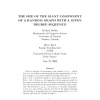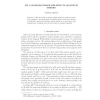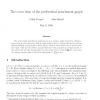COMBINATORICS
1999
14 years 7 months ago
1999
We prove that the threshold for a random graph to have a k-core is equal to the threshold for having a subgraph which meets a necessary condition of Gallai for being k-critical. 1...
CPC
1998
14 years 7 months ago
1998
Given a sequence of non-negative real numbers 0 1 ::: which sum to 1, we consider a random graph having approximately in vertices of degree i. In 12] the authors essentially show ...
CPC
2007
14 years 7 months ago
2007
We show that a random graph studied by Ioffe and Levit is an example of an inhomogeneous random graph of the type studied by Bollob´as, Janson and Riordan, which enables us to gi...
COMBINATORICS
2000
14 years 7 months ago
2000
It is shown in this note that with high probability it is enough to destroy all triangles in order to get a cover graph from a random graph Gn,p with p log n/n for any constant ...
AML
2004
14 years 7 months ago
2004
Assuming CH, let 1 be the saturated random graph of cardinal
JCT
2007
14 years 7 months ago
2007
The preferential attachment graph Gm(n) is a random graph formed by adding a new vertex at each time step, with m edges which point to vertices selected at random with probability...
RSA
2006
14 years 7 months ago
2006
We study the question as to when a random graph with n vertices and m edges contains a copy of almost all graphs with n vertices and cn/2 edges, c
RSA
2006
14 years 7 months ago
2006
We analyze Markov chains for generating a random k-coloring of a random graph Gn,d/n. When the average degree d is constant, a random graph has maximum degree (log n/ log log n), ...
ENDM
2007
14 years 7 months ago
2007
Let ccl(G) denote the order of the largest complete minor in a graph G (also called the contraction clique number) and let Gn,p denote a random graph on n vertices with edge probab...
CPC
2007
14 years 7 months ago
2007
We study a dynamically evolving random graph which adds vertices and edges using preferential attachment and is “attacked by an adversary”. At time t, we add a new vertex xt a...




